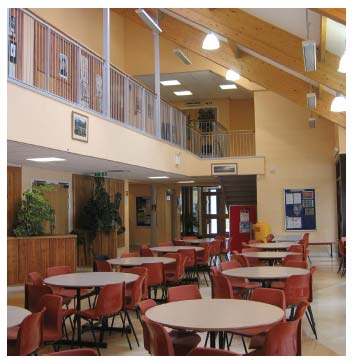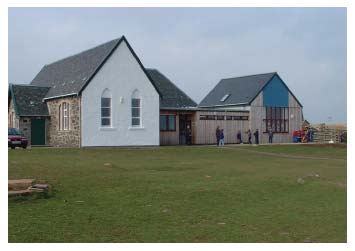Commission on the Delivery of Rural Education: report
The independent commission on the Delivery of Rural Education was established by the Scottish Government and COSLA in July 2011.
This Report makes recommendations on the delivery of all aspects of education in rural areas.
Chapter 5: School buildings
74. It is widely acknowledged that much of the current rural school estate across Scotland was established in the 19th century and that this may no longer match current requirements in relation to the fabric, layout, energy requirements or wider sustainability of the estate.
75. The Commission visited a variety of school buildings and experienced some of the benefits which can be gained for children and young people in purpose built, modern facilities. It was noted that new schools were impressive, raised aspiration and added value to the community where they were located, especially where a community hub offered more than a single service. It is clear that many small rural schools face problems around sufficient physical space, particularly for PE, as these requirements are greater in modern education. The Commission noted that some communities seem more willing to accept a school closure if the new facility is an improved one, albeit further away, or come round to support it once they experience the new facility. However, it is not achievable to provide new school buildings when every merger is proposed and local authorities can only do so on a priority basis.
76. On the other hand, the Commission noted that many of the older small rural school buildings do continue to meet the needs of modern education adequately and may have specific advantages including ready access to the outdoor environment. This is a positive benefit to the pupils and one which many urban schools could not easily replicate ( e.g. links to crofting, kayaking, forests etc). Pupils, generally, commented on how much they enjoyed playing and learning outside when asked to identify what they liked about their school. The Commission also noted good links between schools and village halls, where a school using the hall helped sustain this facility for the community (and, conversely school closure might threaten the viability of the hall). However, the standard of these facilities and their convenience varied.
Ardnamurchan High School (Highland)

Community impact
The Commission visited a thriving 160-pupil school serving the east mainland of Orkney. It was opened in 1996 and combined two smaller schools, both of which were in need of rebuilding. The proposed site for the new school was in the parish of St Andrews and this meant that the parish of Holm would lose a school within its physical boundaries. A number of members of the community were very much against this and held the very first opting out ballot under recently introduced legislation in Scotland. However, this was unsuccessful.
Now there is widespread consensus that the amalgamation was very good for the pupils, the staff and the respective communities. The school excels in sports and team games and has a school band and an orchestra. The communities are thriving, attracting newcomers, and it is the only school in Orkney with a growing roll, so much so that the Council is currently planning to extend the accommodation. Parents regard the school as "the perfect size".
Contact:
customerservice@orkney.gov.uk
Bunessan Primary School (Argyll and Bute)

Community use of schools
77. School buildings should be used by as many community groups as possible. It represents best value for the local authority to make maximum use of its asset and can provide important facilities for the community. This type of usage, sometimes denoted as a 'community school', is based around close engagement between school and community and local partners to deliver a wide, accessible range of services, opportunities and facilities to complement those available elsewhere in the community. 10
78. The Commission noted numerous positive examples where rural school buildings were used by a variety of groups (including wraparound care groups), sometimes with very low or no charges, and very flexible approaches from headteachers. This made a significant contribution to community wellbeing. However, the Commission heard of many community groups who were unable to access the school for lets due to either the costs associated with the let or the need for a key holder to be present on site at all times (due to health and safety guidelines or council policy). These groups requested that arrangements be more flexible to allow them to make use of the school as a community building. It was noted that enhanced rights of access must be exercised responsibly by communities and occasional problems were likely but should not restrict reasonable use of an asset.
79. The Commission encountered parents and community members who voiced a concern that procurement and health and safety legislation prevented school staff or parents pursuing small actions to improve their schools using local contractors or community members at no or lower cost than the normal procedures. The Commission understands that local authorities are encouraged to maintain a balanced approach to encourage local trades people and businesses to be involved in their community whilst striving for the most effective use of public money. It was clear that local authority policy varied widely in its flexibility and the Commission would encourage local authorities to develop more uniformly constructive policies of accepting community assistance at schools ( see example).
Recommendation 14:
Schools and local authorities should promote use of school buildings by community groups.
Recommendation 15:
Local authorities should encourage and accept help with school fabric and maintenance from parents and communities where appropriate.
Future use of school buildings
80. It would be helpful for the local authority to address clearly in a school closure consultation what future use of the school building is proposed. In some situations a positive approach is to make the building available to the community to maintain a public or community function in the location. Where there is not demand for this, sale for housing or commercial development may be the preferred option and this is likely to be better than the building deteriorating unused.
81. It is important that local authorities resolve any legal issues around their options to dispose of a school building and these should be addressed prior to consultation so that communities can consider a clear proposal. The Commission heard from many local authorities that have empty school buildings which could be put to alternate use by community groups but were hindered by the historical ownership of the land or building. Legislation such as the School Sites Act 1841 and the Education (Scotland) Act 1945 allowed landowners to sell or donate a maximum of one acre of land to charities/religious bodies for the provision of schooling. This land then reverted back to the original owner if the school ceased to exist. Legal teams across Scotland have spent years trying to locate and identify the original owners in order to dispose of the land properly. This incurs both time and costs for the local authority and can mean a former school remains empty and unused for a long period. Local authorities would welcome more clarity and support on the legal issues they face, to help resolve the future of a school building without the current delays.
Recommendation 16:
The Scottish Government should seek to provide more clarity and support on the legal issues faced by local authorities over some school buildings, to help resolve the future of these buildings without lengthy delays.
Recommendation 17:
Local authorities should address clearly the future use of a school building in any consultation document proposing school closure.
Contact
There is a problem
Thanks for your feedback